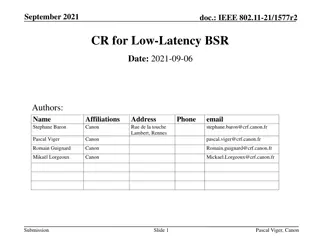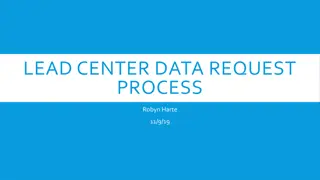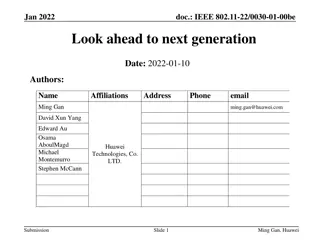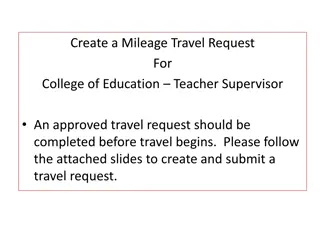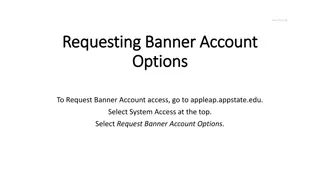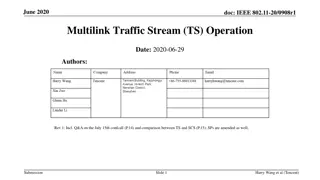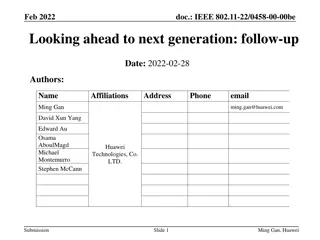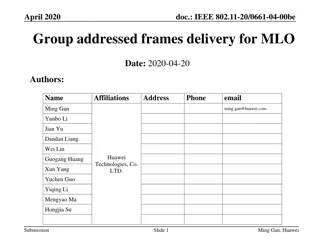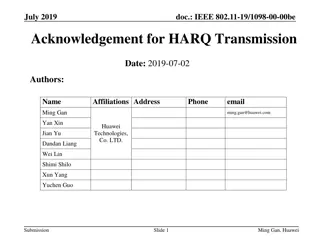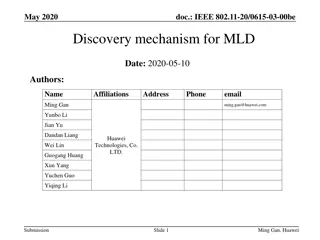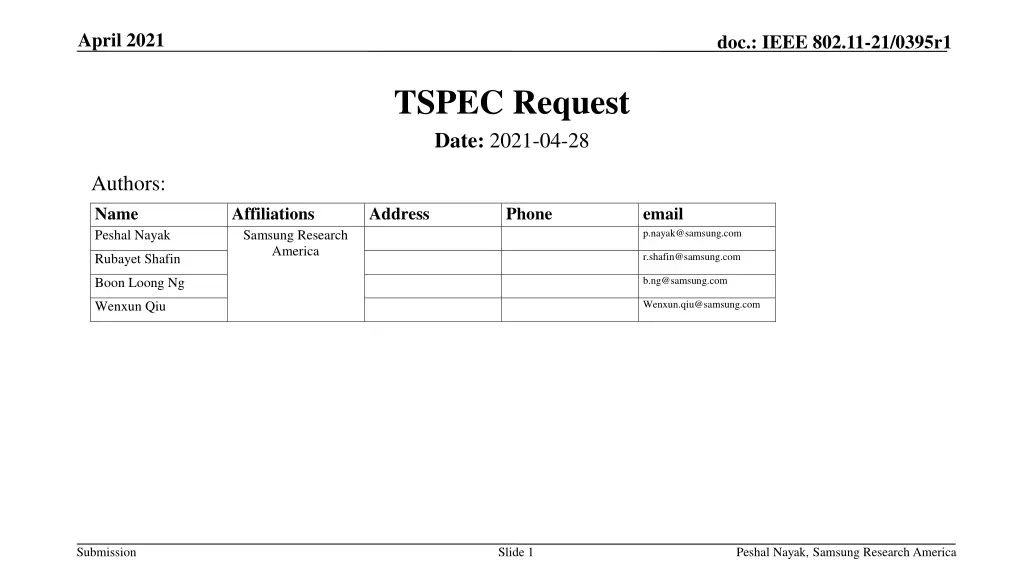
IEEE 802.11-21/0395r1 TWT Setup Proposal for Enhanced Traffic Information
Discover the proposal for enriching traffic information exchange between non-AP devices and APs in the context of IEEE 802.11 standards. Learn how this enhancement can lead to more efficient communication and better traffic pattern understanding.
Download Presentation

Please find below an Image/Link to download the presentation.
The content on the website is provided AS IS for your information and personal use only. It may not be sold, licensed, or shared on other websites without obtaining consent from the author. If you encounter any issues during the download, it is possible that the publisher has removed the file from their server.
You are allowed to download the files provided on this website for personal or commercial use, subject to the condition that they are used lawfully. All files are the property of their respective owners.
The content on the website is provided AS IS for your information and personal use only. It may not be sold, licensed, or shared on other websites without obtaining consent from the author.
E N D
Presentation Transcript
April 2021 doc.: IEEE 802.11-21/0395r1 TSPEC Request Date: 2021-04-28 Authors: Name Peshal Nayak Affiliations Samsung Research America Address Phone email p.nayak@samsung.com r.shafin@samsung.com Rubayet Shafin Boon Loong Ng b.ng@samsung.com Wenxun Qiu Wenxun.qiu@samsung.com Submission Slide 1 Peshal Nayak, Samsung Research America
April 2021 doc.: IEEE 802.11-21/0395r1 Abstract In this contribution, we propose the support for traffic information request from a non-AP STA or non-AP MLD to an AP or AP MLD. Submission Slide 2 Peshal Nayak, Samsung Research America
April 2021 doc.: IEEE 802.11-21/0395r1 Background To assist a non-AP STA or non-AP MLD to specify a suggested/demanded set of TWT parameters in TWT Setup (Suggest TWT and Demand TWT in TWT Setup Command), it would be beneficial if the AP or AP MLD can provide information about the expected traffic pattern in the DL for a traffic flow for the non-AP STA or non-AP MLD It should be possible for the non-AP STA or non-AP MLD send a request to the AP or AP MLD for providing such information Submission Slide 3 Peshal Nayak, Samsung Research America
April 2021 doc.: IEEE 802.11-21/0395r1 Motivation In many cases, STAs may not have the necessary traffic profile information, especially for downlink. Sometimes the STA may have the inaccurate information. For instance, in high contention case, timing information may be disordered, and hence information like burst size and service starting time maybe inaccurate. Providing this information by the AP/AP MLD would help the non-AP STA/non-AP MLD in better traffic detection Submission Slide 4 Peshal Nayak, Samsung Research America
April 2021 doc.: IEEE 802.11-21/0395r1 Motivation 1 0 1 1 AP side DL timing info 1 2 3 7 8 9 4 5 6 STA side DL timing info 4 5 6 7 8 9 1 2 3 doze TWT SP doze doze Fig. 1 Example to depict the difference between DL timing information available at the AP side and that at the non-AP STA or the non-AP MLD. Only DL packets are shown for simplicity DL timing information available at the STA is affected by a number of factors E.g., TWT settings, high contention, etc. DL timing information available at the STA side may not be accurate for computation of some of the fields in the TSPEC element E.g., Burst size, traffic type, etc. Submission Slide 5 Peshal Nayak, Samsung Research America
April 2021 doc.: IEEE 802.11-21/0395r1 Motivation A single application can support more than one type of traffic A number of applications support more than one type of traffic. E.g., Social media apps support video, audio, messaging related features A number of applications can be run from within a web browser. E.g., YouTube, news channel websites, etc. Even with knowledge of the application running, the STA may not have the necessary traffic profile information for DL traffic Submission Slide 6 Peshal Nayak, Samsung Research America
April 2021 doc.: IEEE 802.11-21/0395r1 TSPEC Request We propose to define a new IE called TSPEC request IE - The TSPEC request IE is sent by the non-AP STA or non-AP MLD to the AP or AP MLD - It includes a TID bitmap to indicate the information for which TID(s) are being requested Upon receiving the TSPEC request IE, the AP or AP MLD can send the requested information using the TSPEC element(s) or its variant (e.g. TSPEC-lite) to the non-AP STA or non-AP MLD - The TSPEC element(s) correspond to the characteristics of the traffic flow in DL for the requested TID(s) Submission Slide 7 Peshal Nayak, Samsung Research America
April 2021 doc.: IEEE 802.11-21/0395r1 SP 1 Do you agree to add the following to 11be R1: The non-AP STA or non-AP MLD may send a TSPEC request IE to the AP or AP MLD to request for the DL traffic characteristic of a traffic flow Upon receiving the TSPEC request IE, the AP or AP MLD can send the requested information using the TSPEC element(s) or its variant (e.g. TSPEC-lite) to the non-AP STA or non-AP MLD Submission Slide 8 Peshal Nayak, Samsung Research America





